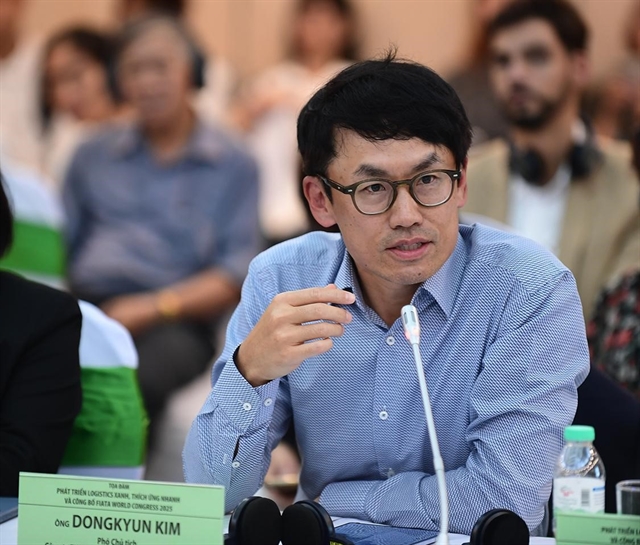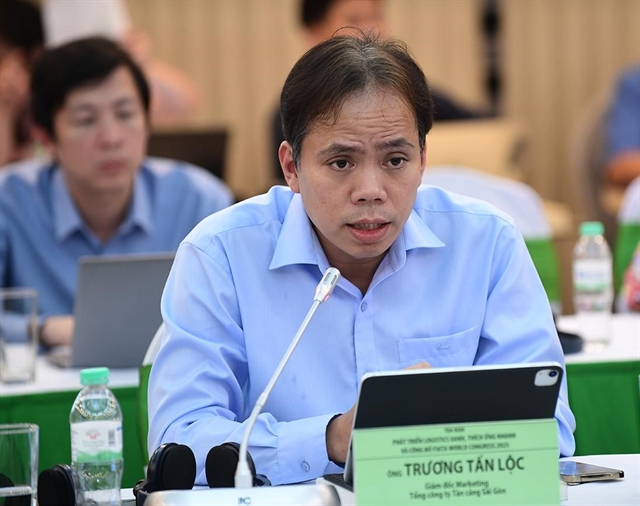Government Resolution No 163/NQ-CP dated December 16, 2022, aimed at fostering the comprehensive implementation of key tasks and solutions to enhance Vietnam’s competitiveness and develop its logistics services, emphasises the importance of a ‘sustainable supply chain development’ in the logistics sector.
In today’s context, green supply chains have evolved from being a mere trend to an indispensable requirement, encompassing practices like environmentally-friendly production and sustainable operations.
Representatives from business associations and businesses talk about the requirements for quick adaptation of firms, as well as supply chains, in the face of global economic fluctuations.
Lê Duy Hiệp, Chairman of Việt Nam Logistics Business Association (VLA)
 |
Green growth and sustainable development have emerged as indispensable and irreversible imperatives, representing a prevailing global trend in the present era. Moreover, the national green growth strategy outlines a comprehensive objective of promoting economic restructuring, intertwined with innovative growth models, environmental sustainability and social equity.
Within the logistics industry, adopting green practices is no longer a mere trend – it has become an obligatory requirement for businesses. Notably, numerous prominent logistics enterprises worldwide, including shipping lines and seaport companies, have proactively embarked on emission reduction and green energy adoption initiatives ahead of their respective countries’ commitments.
Presently, the transportation sector alone accounts for 24 per cent of worldwide emissions. Embracing green and adaptive logistics practices will play a pivotal role in reducing carbon footprints within the Vietnamese logistics industry.
The pursuit of green supply chains is no longer a futuristic notion, it is an immediate imperative. It transcends being a mere choice and has become an essential necessity. The development of green supply chains aligns with the vital goal of achieving net-zero emissions, to which Việt Nam has committed at COP26.
DongKyun Kim, Vice President of Samsung SDS Southeast Asia
 |
Transparency emerges as the most significant challenge within the supply chain, as customers demonstrate limited comprehension. According to our survey, only approximately six per cent of customers possess a comprehensive understanding of the supply chain, while 15 per cent have partial knowledge, leaving a substantial 79 per cent unfamiliar with the specific formation of the supply chain.
This lack of comprehensive understanding poses several risks. Businesses may encounter production delays due to insufficient information regarding inventory levels. Freight shipments may suffer from sluggishness and warehouse management can encounter multiple issues. Recognising this reality, we have taken proactive measures to leverage technology and digital transformation, aiming to minimise these risks.
Traditionally, warehouse management relied heavily on manual processes. With hundreds of thousands of orders being handled manually each day, the potential for errors and omissions was significant, negatively impacting quality, costs and operational efficiency. However, since implementing automated warehouse management, our records indicate a 15 per cent reduction in errors within just four weeks.
In addition to warehousing challenges, the timely delivery of goods often faces delays. Many businesses resort to deploying human resources to manually inspect goods, requiring extensive labour efforts. However, when the system is automated and self-checking, these labour-intensive tasks are reduced, enabling businesses to devise more effective plans. Notably, with the advancements in technology, AI applications have emerged as valuable tools for minimising risks.
Việt Nam benefits from Samsung’s robust database system, which serves as a reliable source of input. Leveraging such resources, AI applications can provide businesses with the most accurate and standardised information, offering optimal support.
Through our digital transformation efforts, we assist businesses in achieving better management, reducing risks, optimising travel routes, maximising cart filling rates and ensuring effective daily route updates. Consequently, transportation costs are minimised, promoting both efficiency and environmental sustainability.
Trương Tấn Lộc, Marketing Director of Saigon New Port Corporation
 |
As a trailblazer in business operations, Saigon New Port Corporation is actively embracing transformative methodologies and gradually reshaping customer habits. A significant focus is placed on the development of waterway transport, a sustainable transportation model that effectively reduces greenhouse gas emissions. Concurrently, the implementation of digital transformation solutions plays a crucial role in optimising operations, enhancing customer services, streamlining production organisation within port areas and minimising waiting times and freight forwarding for customers, thereby mitigating environmental emissions.
The company leverages information technology for efficient freight forwarding services, both for customers and ships, through a dedicated commercial transaction portal. Notably, the introduction of a mobile app empowers customers to conduct transactions and goods delivery using their smartphones, eliminating the need for paper and reducing overall processing time. Additionally, the port actively embraces modernisation by adopting technical measures and transitioning equipment from traditional power sources to solar energy. Through strategic investments in cutting-edge equipment, the port aims to establish semi-automatic and automatic facilities in the near future, bolstering efficiency and sustainability.
Phạm Thị Bích Huệ, Chairwoman of Western Pacific Group (WPG)
 |
In Việt Nam, we are implementing the logistics industry cluster model and as a logistics operator, I would like to share my opinions on the crucial aspect of synchronised logistics development. As mentioned earlier, warehousing plays a pivotal role in the adoption of green logistics practices. However, this remains a distant challenge, particularly considering that 90 per cent of businesses in the industry are medium, small and micro enterprises. A common concern revolves around the perceived costliness of implementing green logistics. In my view, this represents an opportunity that cannot be missed.
In my opinion, the cost aspect is not as daunting as it may seem. Businesses that lack the means to switch to more expensive fuels can still apply optimisation solutions to achieve sustainability goals.
In the Vietnamese logistics landscape, transportation costs account for over 50 per cent of the total, resulting in significant emissions. Among numerous solutions, there are approaches to reducing the emission rates of CO gas and maximising the utilisation of renewable energy sources.
For industrial park operators, in addition to fuel-saving measures, we recommend adopting a comprehensive approach, namely synchronous planning. By fostering synchronisation between manufacturers and logistics centres, we can optimise transportation routes. In this context, government regulations play a crucial and evident role.
From a business standpoint, we are implementing the cluster model on a smaller scale. The industrial park model is tailored for each specific location, such as proximity to the sea or airport, enabling the optimisation of routes and time efficiency.
Furthermore, we urge the government to continue supporting the promotion of renewable energy. Several technical and policy matters related to this issue have emerged recently. Therefore, we hope the government recognises the distinct role of renewable energy in the context of green logistics.
Drawing from our business experience, while the value may not be immediately apparent at first, implementing green logistics has yielded numerous direct and indirect impacts. For instance, a single hectare of warehouse space can accommodate an investment of 1 MW of renewable energy, which is equivalent to planting 20,000 trees and reducing approximately 1,400 CO2 emissions. This model should be shared and garner increased support from agencies such as the Ministry of Industry and Trade to foster growth among green logistics businesses. VNS
- Reduce Hair Loss with PURA D’OR Gold Label Shampoo
- Castor Oil Has Made a “Huge” Difference With Hair and Brow Growth
- Excessive hair loss in men: Signs of illness that cannot be subjective
- Dịch Vụ SEO Website ở Los Angeles, CA: đưa trang web doanh nghiệp bạn lên top Google
- Nails Salon Sierra Madre
 VnExpress News The News Gateway of Vietnam
VnExpress News The News Gateway of Vietnam




